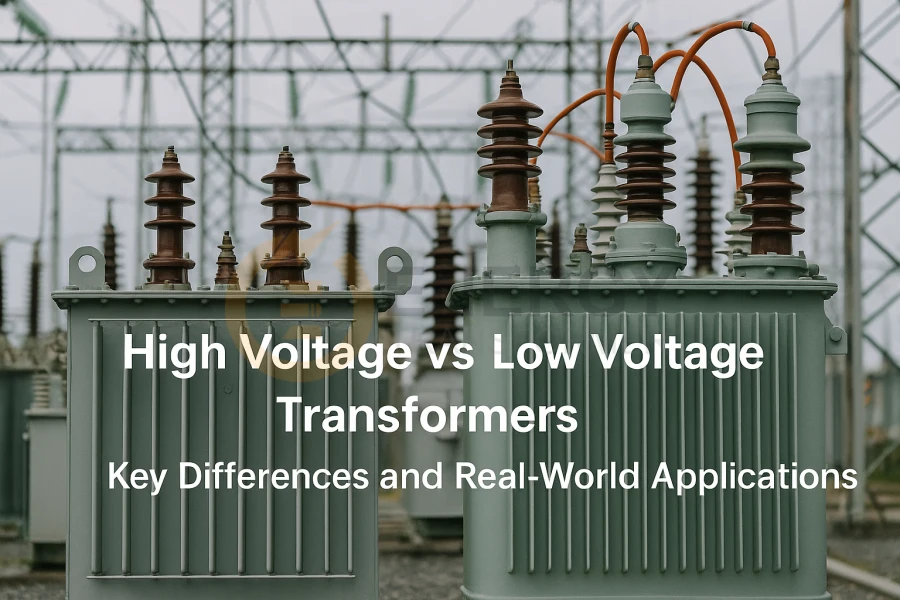Understand the technical and practical differences between high-voltage and low-voltage transformers, including design, safety, and global application scenarios for industrial and utility use.
Transformers are fundamental to modern electrical grids, playing a crucial role in stepping voltage up or down to facilitate efficient power transmission and distribution. While their core function remains the same, high-voltage (HV) transformers and low-voltage (LV) transformers are designed and applied very differently. Understanding these distinctions is paramount for anyone involved in power system design, procurement, or operation, whether in North America, Europe, or South America.
This guide will explore the essential differences between HV and LV transformers, their typical applications, and why choosing the correct voltage level transformer is vital for safety, efficiency, and compliance in various global markets.
1. Introduction: Why Voltage Level Matters
In the world of electrical engineering, voltage level dictates almost every aspect of equipment design and application. For transformers, this distinction is particularly critical. A transformer's voltage rating determines its construction, insulation requirements, safety protocols, and ultimately, its role within the power delivery chain.
-
Voltage Level Definition: Broadly, high voltage typically refers to levels equal to or greater than 35 kV (in North America) or 36 kV (under European standards), used for long-distance power transmission. Low voltage refers to levels below 1 kV (typically 400V / 230V), used for local distribution and end-user consumption.
-
Role in Power Systems: HV transformers are at the heart of power transmission, stepping up generator output for efficient long-haul transport and then stepping it down at substations. LV transformers bring power down to usable levels for industries, commercial buildings, and homes.
-
Why Understanding Differences is Crucial: Selecting the wrong transformer for a given voltage level can lead to catastrophic failures, safety hazards, and significant economic losses due to inefficiency or non-compliance with regional standards.
2. What Is a High Voltage Transformer?
A high voltage transformer is engineered to handle substantial voltage levels, typically 35 kV or above. These are the giants of the transformer world, designed for the rigorous demands of power transmission networks.
-
Definition: Generally defined as transformers operating at voltages of 35 kV and above in North America, or 36 kV and above under IEC (European) standards.
-
Application Scenarios: They are primarily used at power generation stations to step up voltage for efficient long-distance transmission, and at main substations to step down transmission voltages for further distribution. They are integral to power grids.
-
Common Voltage Ratings: Examples include 110 kV, 132 kV, 220 kV, 400 kV, and even higher (e.g., 765 kV) for ultra-high voltage transmission.
-
Key Characteristics:
-
High Insulation Requirements: Given the extreme voltages, these transformers require robust insulation systems. They are almost exclusively oil-immersed transformers (using mineral oil or synthetic esters for insulation and cooling) or SF₆ gas-insulated for compact designs.
-
Large Volume and Complex Cooling: Their size is considerable, housing massive windings and cores. They often feature complex forced-air or oil cooling systems (e.g., ONAN, ONAF, OFAF) to dissipate the significant heat generated.
-
Strict Safety and Grounding: Due to the inherent dangers of high voltages, strict safety clearance distances and advanced grounding requirements are mandated.
-
Learn More:Transformer Efficiency Standards and Loss Analysis: A Complete Guide (IEC & DOE Compliant)
3. What Is a Low Voltage Transformer?
In contrast, a low voltage transformer deals with voltages typically below 1 kV, bringing electricity to the point of use. These are the workhorses of local distribution.
-
Definition: Operate at voltages 1 kV or below, commonly delivering standard industrial and residential voltages like 400V, 230V, 480V, 208V, or 120V.
-
Application Scenarios: Found in diverse settings, including industrial facilities (e.g., powering machinery, control panels), commercial buildings, residential areas for service entry, and even within specific electronic devices.
-
Common Types: Often dry-type transformers (air-cooled or resin-encapsulated), control transformers, and smaller autotransformers.
-
Key Characteristics:
-
Flexible Installation & Compact Size: Their smaller footprint allows for more versatile installation in tight spaces, indoors or outdoors.
-
Simpler Maintenance: Generally easier and safer to maintain, often not requiring specialized fluids or gases.
-
Integrated Protection: Commonly equipped with overload protectors or fuses for integrated safety, making them ideal for localized distribution.
-
Learn More:How Transformers Regulate Voltage: From Substations to Your Power Infrastructure
4. Key Technical Differences Between High and Low Voltage Transformers
The fundamental disparities between HV and LV transformers extend beyond just their voltage ratings, encompassing their design, operational characteristics, and safety considerations.
| Feature | High Voltage Transformer | Low Voltage Transformer |
|---|---|---|
| Operating Voltage | 35kV and above (Americas), 36kV and above (Europe) | Below 1kV |
| Typical Applications | Power transmission, main substations | Local distribution, industrial machinery, buildings |
| Insulation System | Oil-immersed, gas-insulated (SF₆) | Air-cooled (varnish/resin), dry-type |
| Cooling Method | Oil circulation, forced air (fans), water cooling | Natural air convection, fan-assisted (for larger LV units) |
| Size and Weight | Large and heavy (requiring special transport) | Compact and lightweight |
| Safety Requirements | Strict clearance zones, robust grounding, fire suppression | Basic electrical safety, overcurrent protection |
| Maintenance Frequency | Regular, highly regulated, specialized procedures | Generally low-maintenance, routine checks |
5. Application Scenarios in Global Markets
The specific use cases for HV and LV transformers vary slightly across different global regions due to unique grid structures, industrial landscapes, and regulatory environments.
5.1 North America (US, Canada)
-
High Voltage: Predominantly used in substation transformers (ranging from 69kV to 230kV and higher) for utility transmission grids. Increasingly vital for renewable energy integration, connecting large-scale solar and wind farms to the main grid.
-
Low Voltage: Widely deployed for industrial motor supply, commercial panel boards, and within building transformers to step down utility voltage for building-wide distribution (e.g., 480V, 208V).
5.2 Europe (Germany, UK, France, etc.)
-
High Voltage: Crucial for transmission networks (e.g., 110kV, 220kV, 400kV) that often span across national borders. Key for integrating large offshore wind farms and other renewable energy sources.
-
Low Voltage: Essential for smart buildings, EV charging stations infrastructure, and various control panels in manufacturing and automation. The 400V/230V system is standard for most LV applications.
5.3 South America (Brazil, Argentina, etc.)
-
High Voltage: Plays a significant role in hydro-based generation grids, where power is often generated far from consumption centers and requires long-distance transmission.
-
Low Voltage: Drives commercial infrastructure development and is fundamental to rural electrification projects, bringing power to remote communities.
6. Compliance & Standards
Ensuring transformers meet relevant international and regional standards is non-negotiable for market entry and operational safety.
-
IEC 60076 Series: The globally recognized International Electrotechnical Commission (IEC) 60076 series sets comprehensive standards for power transformers, covering design, testing, and performance for both high and low voltage transformers.
-
DOE 2016 (USA): The U.S. Department of Energy (DOE) 2016 efficiency standards mandate stringent low voltage efficiency requirements for new distribution transformers sold in the USA, aiming to reduce energy losses.
-
EN 50588-1: This European standard specifically covers European distribution transformer efficiency regulations, aligning with the Ecodesign Directive for placing transformers on the EU market.
-
NEMA ST20: In North America, NEMA ST20 provides standards for dry-type transformers, including performance and construction guidelines.
Learn More:Key Components of a Power Transformer: Core, Windings, and Insulation
7. Selection Tips: Which Transformer to Use?
Choosing the right transformer goes beyond just voltage; it involves a holistic assessment of your project's needs.
-
Match Voltage Levels: Always start by ensuring the transformer's primary and secondary voltage ratings precisely match your engineering application needs (e.g., industrial use or power transmission and distribution).
-
Application Requirements: Consider the specific demands of your application. Is it a critical utility substation, a dusty factory floor, or a commercial building? This influences the required insulation class, cooling method, and protective features.
-
Installation Environment: Evaluate the installation environment. Is it indoor/outdoor, what are the altitude and humidity levels, and are there specific fire safety concerns that might necessitate a dry-type transformer over an oil-immersed one?
-
Smart Features: For modern grids and facilities, consider if you need a smart transformer with remote monitoring capabilities or digital management for enhanced control, efficiency tracking, and predictive maintenance.
8. Common Mistakes and Misunderstandings
Navigating transformer selection can be complex, and some common pitfalls can lead to costly errors:
-
Confusing Control vs. Distribution Transformers: Many mistake small low-voltage control transformers (for circuitry) with larger low-voltage distribution transformers (for power supply), leading to misapplications.
-
Ignoring Safety Details: Overlooking critical safety details like proper grounding, overload protection, and required clearance distances is dangerous and non-compliant.
-
Neglecting Energy Loss and Efficiency Ratings: Especially in regulated markets like Europe and North America, failing to consider energy loss and efficiency ratings (e.g., DOE 2016 or Ecodesign Tier 2) can result in higher operating costs and legal penalties.
9. Energy Transformer Product Offering
At Energy Transformer, we are your trusted partner for comprehensive transformer solutions, serving clients across North America, Europe, and South America. We understand the critical differences between high-voltage and low-voltage applications and offer a complete range of transformers designed for safety, efficiency, and reliability.
We provide full-series transformer solutions, from small 0.5 kV low-voltage control transformers to massive 220 kV high-voltage power transformers. Our products are rigorously tested and come with essential certifications for global markets, including UL (for North America), CE (for Europe), ISO, and compliance with IEC standards.
With factory-direct supply, we support OEM, wholesale, and engineering customization to meet your specific project requirements. We proudly serve a wide array of countries, including the United States, Canada, the United Kingdom, Germany, France, the Netherlands, Italy, Spain, Portugal, Brazil, Chile, and more. Choose Energy Transformer for one-stop procurement and expert technical guidance every step of the way.
10. Conclusion
The distinction between high-voltage and low-voltage transformers is fundamental to the design and operation of any electrical system. Understanding their technical differences, typical applications, and the specific standards they must meet is paramount for ensuring the safety and efficiency of your electrical infrastructure.
Selecting the correct voltage level transformer and partnering with an experienced, certified supplier like Energy Transformer is key to a successful, compliant, and cost-effective power solution.
Ready to find the perfect high-voltage or low-voltage transformer for your next project?
Contact Energy Transformer today to discuss your specific needs and receive expert advice!

